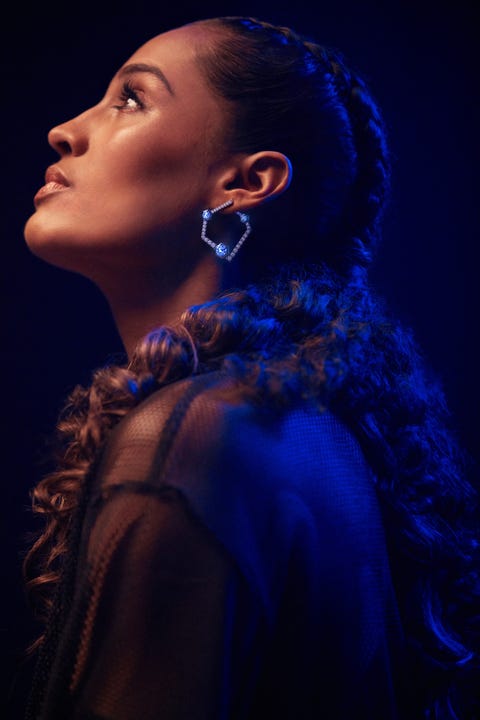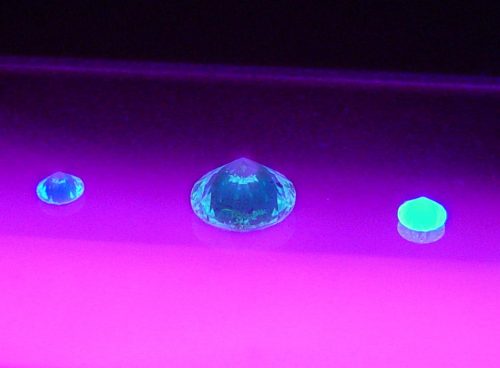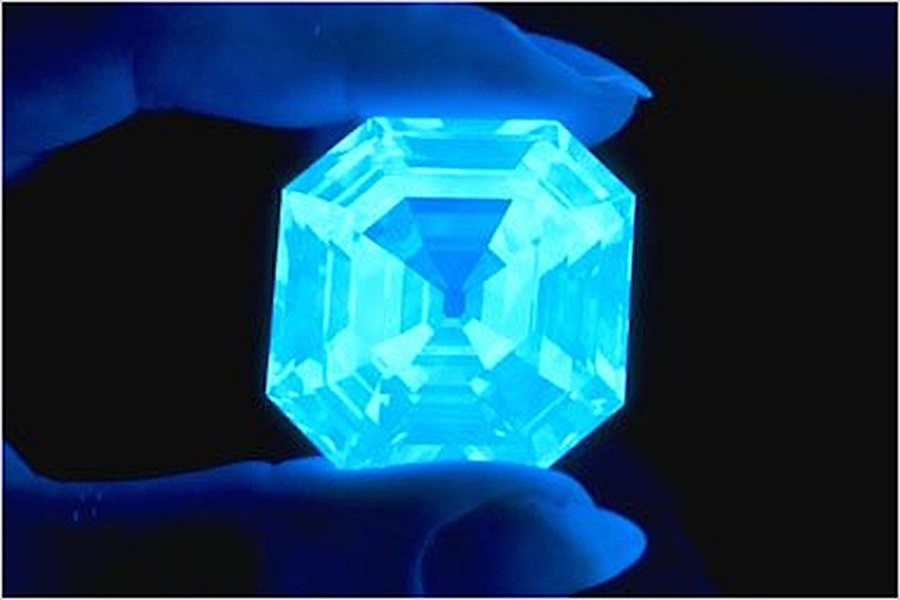The Effect of Strong Blue Fluorescence in Diamonds
The term “Overblue” refers to a diamond that exhibits strong blue fluorescence when exposed to long-wave ultraviolet (UV) light. This phenomenon occurs when the diamond absorbs UV light and emits a visible blue glow. While fluorescence in diamonds can be a natural and even desirable trait in some cases, an overblue diamond refers specifically to stones with extremely strong blue fluorescence, which can sometimes negatively impact their appearance.
Understanding Fluorescence in Diamonds
1. What is Fluorescence?
Fluorescence in diamonds is a natural occurrence that happens when a diamond absorbs ultraviolet light and then re-emits it as visible light, typically as a blue glow. Not all diamonds exhibit fluorescence, and its intensity can vary from none to very strong. Fluorescence is often graded on a scale from none to very strong, with the most common colors being blue (the most desirable) or less frequently yellow and green.
2. Types of Fluorescence
None: No fluorescence; the diamond remains unchanged under UV light.
Faint to Medium: Noticeable fluorescence, but usually doesn’t significantly impact the diamond’s appearance under normal lighting.
Strong to Very Strong: A bright, noticeable glow, which may be more obvious under UV light or in low-light conditions. In the case of overblue diamonds, this fluorescence is very intense and can affect the diamond’s overall appearance.
What Makes a Diamond Overblue?
An overblue diamond refers to a diamond with extremely strong blue fluorescence. This can result in a distinctive blue glow that may be evident under long-wave UV light or sometimes even in regular daylight. While fluorescence can enhance the diamond’s appearance in certain conditions, an overblue diamond can present issues for the stone’s overall aesthetic and value.
Issues with Overblue Diamonds
1. Oily or Milky Appearance in Daylight
Diamonds with strong fluorescence can appear cloudy, oily, or milky under normal daylight or incandescent lighting, which can affect their brilliance. This happens because the fluorescence can cause the diamond to scatter light unevenly, diminishing its overall sparkle.
High-color diamonds (D-F grades) with strong fluorescence are often the most affected, as their lack of color accentuates the milky or oily appearance.
2. Misleading Perception of Superior Colour
In the past, the term “overblue” was sometimes used to suggest that a diamond with strong blue fluorescence had a superior color grade, leading to confusion in the market. Some buyers believed that a strong blue fluorescence was an indicator of a higher-quality diamond.
However, fluorescence does not directly correlate with the color grade of a diamond, and a diamond’s appearance under normal lighting is far more important in assessing its true beauty.
3. Impact on Diamond Value
While some buyers find fluorescence attractive, an overblue diamond can decrease the diamond’s market value. This is because it affects the overall visual quality, particularly if the stone appears cloudy or oily under natural light.
Diamonds with extremely strong fluorescence can also be perceived as less desirable due to the unpredictable visual effects they may exhibit in different lighting environments.
Should You Avoid an Overblue Diamond?
Whether or not to buy an overblue diamond depends on your personal preferences and how the diamond appears to you in real-world lighting.
Reasons to Avoid an Overblue Diamond
Aesthetic Concerns: The milky or oily look that can appear under normal lighting may not appeal to everyone, especially those seeking a diamond with the highest possible brilliance and clarity.
Reduced Value: Overblue diamonds may be worth less in the market compared to their counterparts with less noticeable fluorescence.
Reasons to Consider an Overblue Diamond
Personal Preference: Some people enjoy the blue glow that fluorescence provides, especially under UV light.
Price: Due to the perceived lower value, diamonds with strong fluorescence may be available at a lower price, which could appeal to those on a budget.
How to Detect Overblue Fluorescence
If you’re interested in purchasing a diamond, it’s essential to check the fluorescence grading and assess how it might affect the diamond’s appearance.
1. Check the Diamond’s Certification
Reputable gemological laboratories like GIA, DCLA, and AGS will include a fluorescence grade on the diamond’s certificate. If the diamond is marked as strong blue or very strong blue, it may exhibit the overblue effect.
2. View the Diamond in Different Lighting
It’s essential to examine the diamond in natural light to see if the overblue fluorescence makes it appear cloudy or oily.
Examine the diamond under UV light to observe the fluorescence intensity and its effect on the stone’s visual appeal.
3. Personal Preference
Ultimately, whether to choose a diamond with strong fluorescence, including overblue, depends on your personal taste and the diamond’s appearance in various lighting conditions. If you are unsure, you may want to consult a gemologist or diamond expert to better understand how fluorescence will affect the look and value of the diamond.
Overblue diamonds exhibit extremely strong blue fluorescence, which can result in a distinct blue glow under UV light. In the past, the term was used misleadingly to suggest that the diamond had a superior color, but it can actually cause the diamond to appear milky or oily in normal daylight, especially for high-color diamonds. Fluorescence in diamonds is a natural phenomenon, but when it is too strong, it can detract from the diamond’s beauty. Whether you should buy an overblue diamond depends on your personal preference for the glow and how it looks in natural light. Be sure to check the fluorescence grading and view the diamond in different lighting before making a purchase decision.






